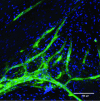Cell interactions in bone tissue engineering
- PMID: 20050963
- PMCID: PMC3837601
- DOI: 10.1111/j.1582-4934.2009.01005.x
Cell interactions in bone tissue engineering
Abstract
Bone fractures, where the innate regenerative bone response is compromised, represent between 4 and 8 hundred thousands of the total fracture cases, just in the United States. Bone tissue engineering (TE) brought the notion that, in cases such as those, it was preferable to boost the healing process of bone tissue instead of just adding artificial parts that could never properly replace the native tissue. However, despite the hype, bone TE so far could not live up to its promises and new bottom-up approaches are needed. The study of the cellular interactions between the cells relevant for bone biology can be of essential importance to that. In living bone, cells are in a context where communication with adjacent cells is almost permanent. Many fundamental works have been addressing these communications nonetheless, in a bone TE approach, the 3D perspective, being part of the microenvironment of a bone cell, is as crucial. Works combining the study of cell-to-cell interactions in a 3D environment are not as many as expected. Therefore, the bone TE field should not only gain knowledge from the field of fundamental Biology but also contribute for further understanding the biology of bone. In this review, a summary of the main works in the field of bone TE, aiming at studying cellular interactions in a 3D environment, and how they contributed towards the development of a functional engineered bone tissue, is presented.
Figures



Similar articles
-
Engineering Pre-vascularized Scaffolds for Bone Regeneration.Adv Exp Med Biol. 2015;881:79-94. doi: 10.1007/978-3-319-22345-2_5. Adv Exp Med Biol. 2015. PMID: 26545745 Review.
-
Functionalized cell-free scaffolds for bone defect repair inspired by self-healing of bone fractures: A review and new perspectives.Mater Sci Eng C Mater Biol Appl. 2019 May;98:1241-1251. doi: 10.1016/j.msec.2019.01.075. Epub 2019 Jan 22. Mater Sci Eng C Mater Biol Appl. 2019. PMID: 30813005 Review.
-
Overcoming physical constraints in bone engineering: 'the importance of being vascularized'.J Biomater Appl. 2016 Feb;30(7):940-51. doi: 10.1177/0885328215616749. Epub 2015 Dec 1. J Biomater Appl. 2016. PMID: 26637441 Review.
-
In Situ Bone Tissue Engineering With an Endogenous Stem Cell Mobilizer and Osteoinductive Nanofibrous Polymeric Scaffolds.Biotechnol J. 2017 Dec;12(12). doi: 10.1002/biot.201700062. Epub 2017 Sep 28. Biotechnol J. 2017. PMID: 28925552
-
Nanoparticles for bone tissue engineering.Biotechnol Prog. 2017 May;33(3):590-611. doi: 10.1002/btpr.2469. Epub 2017 Apr 26. Biotechnol Prog. 2017. PMID: 28371447 Review.
Cited by
-
Osteoidosis leads to altered differentiation and function of osteoclasts.J Cell Mol Med. 2020 May;24(10):5665-5674. doi: 10.1111/jcmm.15227. Epub 2020 Apr 13. J Cell Mol Med. 2020. PMID: 32283567 Free PMC article.
-
Integrating Micro- and Nanostructured Platforms and Biological Drugs to Enhance Biomaterial-Based Bone Regeneration Strategies.Biomacromolecules. 2025 Jan 13;26(1):140-162. doi: 10.1021/acs.biomac.4c01133. Epub 2024 Dec 2. Biomacromolecules. 2025. PMID: 39621708 Free PMC article. Review.
-
Coculture effects on the osteogenic differentiation of human mesenchymal stromal cells.Tissue Eng Regen Med. 2016 Dec 17;13(6):713-723. doi: 10.1007/s13770-016-0008-z. eCollection 2016 Dec. Tissue Eng Regen Med. 2016. PMID: 30603452 Free PMC article.
-
Bone physiology as inspiration for tissue regenerative therapies.Biomaterials. 2018 Dec;185:240-275. doi: 10.1016/j.biomaterials.2018.09.028. Epub 2018 Sep 17. Biomaterials. 2018. PMID: 30261426 Free PMC article. Review.
-
Construction of biomimetic cell-sheet-engineered periosteum with a double cell sheet to repair calvarial defects of rats.J Orthop Translat. 2022 Oct 14;38:1-11. doi: 10.1016/j.jot.2022.09.005. eCollection 2023 Jan. J Orthop Translat. 2022. PMID: 36313975 Free PMC article.
References
-
- Dawson JI, Oreffo ROC. Bridging the regeneration gap: stem cells, biomaterials and clinical translation in bone tissue engineering. Arch. Biochem. Biophys. 2008;473:124–31. - PubMed
-
- Jordan KM, Sawyer S, Coakley P, et al. The use of conventional and complementary treatments for knee osteoarthritis in the community. Rheumatology. 2004;43:381–4. - PubMed
-
- Langer R, Vacanti JP. Tissue engineering. Science. 1993;260:920–6. - PubMed
-
- Nerem RM, Sambanis A. Tissue engineering: from biology to biological substitutes. Tissue Eng. 1995;1:3–13. - PubMed
-
- Salgado AJ, Coutinho OP, Reis RL. Bone tissue engineering: state of the art and future trends. Macromol. Biosci. 2004;4:743–65. - PubMed
Publication types
MeSH terms
Substances
LinkOut - more resources
Full Text Sources

